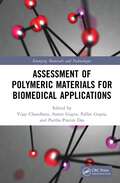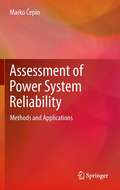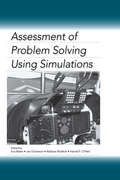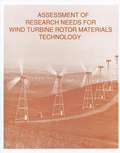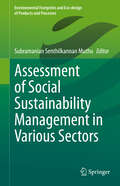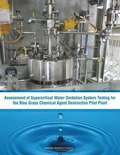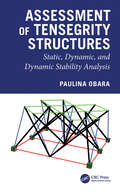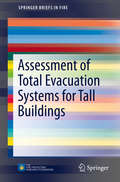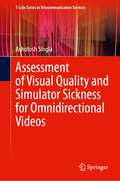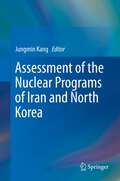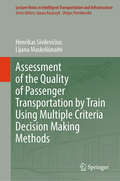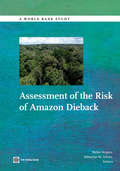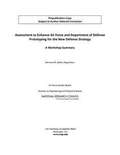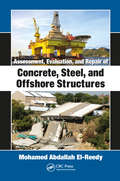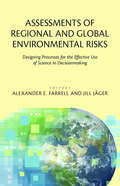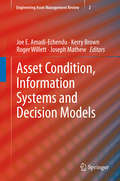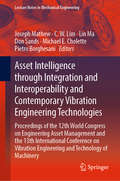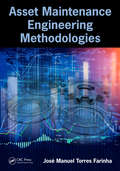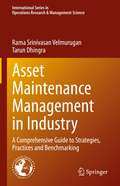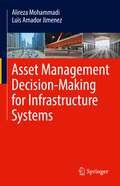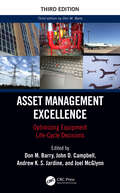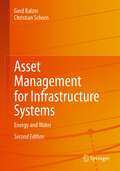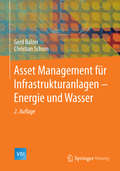- Table View
- List View
Assessment of Polymeric Materials for Biomedical Applications (Emerging Materials and Technologies)
by Sumit Gupta Pallav Gupta Partha Pratim Das Vijay ChaudharyThis book initiates with an introduction to polymeric materials, followed by various classifications and properties of polymeric implant material including various development methods of polymeric materials and their characterization techniques. An overview of various toxicology assessments of polymeric materials and polymeric materials for drug delivery system is also included. Design and analysis of polymeric materials-based components using Ansys software along with polymeric materials for additively manufactured artificial organs are also discussed. Features: Addresses assessment of polymeric materials in biomedical sciences, including classification, properties, and development of polymeric implants. Covers various topics in the field of tissue regeneration. Discusses biocompatibility, toxicity, and biodegradation of polymeric materials. Explores wide-scale characterization to study the effect of inclusion size on the mechanical properties of polymeric materials. Reviews limitations and future directions on polymeric material with emphasis on biocompatibility. This book is aimed at graduate students and researchers in biomaterials, biomedical engineering, composites, and polymers.
Assessment of Power System Reliability: Methods and Applications
by Marko ČepinThe importance of power system reliability is demonstrated when our electricity supply is disrupted, whether it decreases the comfort of our free time at home or causes the shutdown of our companies and results in huge economic deficits. The objective of Assessment of Power System Reliability is to contribute to the improvement of power system reliability. It consists of six parts divided into twenty chapters. The first part introduces the important background issues that affect power system reliability. The second part presents the reliability methods that are used for analyses of technical systems and processes. The third part discusses power flow analysis methods, because the dynamic aspect of a power system is an important part of related reliability assessments. The fourth part explores various aspects of the reliability assessment of power systems and their parts. The fifth part covers optimization methods. The sixth part looks at the application of reliability and optimization methods. Assessment of Power System Reliability has been written in straightforward language that continues into the mathematical representation of the methods. Power engineers and developers will appreciate the emphasis on practical usage, while researchers and advanced students will benefit from the simple examples that can facilitate their understanding of the theory behind power system reliability and that outline the procedure for application of the presented methods.
Assessment of Problem Solving Using Simulations
by Eva Baker Jan Dickieson Wallace Wulfeck Harold F. O’NeilThis volume explores the application of computer simulation technology to measurement issues in education -- especially as it pertains to problem based learning. Whereas most assessments related to problem solving are based on expensive and time consuming measures (i.e., think-aloud protocols or performance assessments that require extensive human rater scoring), this book relies on computerization of the major portion of the administration, scoring, and reporting of problem-solving assessments. It is appropriate for researchers, instructors and graduate students in educational assessment, educational technology, and educational psychology.
Assessment of Research Needs for Wind Turbine Rotor Materials Technology
by Committee on Assessment of Research Needs for Wind Turbine Rotor Materials TechnologyWind-driven power systems represent a renewable energy technology. Arrays of interconnected wind turbines can convert power carried by the wind into electricity. This book defines a research and development agenda for the U.S. Department of Energy's wind energy program in hopes of improving the performance of this emerging technology.
Assessment of Social Sustainability Management in Various Sectors (Environmental Footprints and Eco-design of Products and Processes)
by Subramanian Senthilkannan MuthuThis volume presents a variety of case studies detailing how imperatives of social sustainability are handled in several industries. The first chapter written by the volume editor provides context for social sustainability and explains how the following chapters fit together. The following five chapters detail cases from the textile industry, technology firms, agriculture, and the healthcare industry.
Assessment of Supercritical Water Oxidation System Testing for the Blue Grass Chemical Agent Destruction Pilot Plant
by National Research Council Board on Army Science and Technology Division on Engineering and Physical Sciences Committee to Assess Supercritical Water Oxidation System Testing for the Blue Grass Chemical Agent Destruction Pilot PlantAssessment of Supercritical Water Oxidation System Testing for the Blue Grass Chemical Agent Destruction Pilot Plant reviews and evaluates the results of the tests conducted on one of the SCWO units to be provided to Blue Grass Chemical Agent Destruction Pilot Plant. The Army Element, Assembled Chemical Weapons Alternatives (ACWA) is responsible for managing the conduct of destruction operations for the remaining 10 percent of the nation's chemical agent stockpile, stored at the Blue Grass Army Depot (Kentucky) and the Pueblo Chemical Depot (Colorado). Facilities to destroy the agents and their associated munitions are currently being constructed at these sites. The Blue Grass Chemical Agent Destruction Pilot Plant (BGCAPP) will destroy chemical agent and some associated energetic materials by a process of chemical neutralization known as hydrolysis. The resulting chemical waste stream is known as hydrolysate. Among the first-of-a-kind equipment to be installed at BGCAPP are three supercritical water oxidation (SCWO) reactor systems. These particular hydrolysate feeds present unique non-agent-related challenges to subsequent processing via SCWO due to their caustic nature and issues of salt management.This report provides recommendations on SCWO systemization testing inclusive of durability testing and discusses systemization testing objectives and concepts.
Assessment of Tensegrity Structures: Static, Dynamic, and Dynamic Stability Analysis
by Paulina ObaraThis book enables a proper understanding of tensegrity structures. It contains both theoretical background and examples. First, a geometrically non-linear model and the methods used to evaluate the behavior of tensegrity structures are explained. Next, a broad spectrum of different planar and spatial design solutions is considered.Assessment of Tensegrity Structures is very logically organized, in line with its down-to-earth subject, beginning with the simplest two-dimensional structure, for which solutions can be presented in explicit form, and ending with more complex tensegrity structures used in civil engineering such as domes, towers, and plates. This book is designed for everyone who is interested in tensegrity systems, from beginners to those who want to deepen their knowledge of them.
Assessment of Total Evacuation Systems for Tall Buildings (SpringerBriefs in Fire)
by Enrico Ronchi Daniel NilssonThis SpringerBrief focuses on the use of egress models to assess the optimal strategy for total evacuation in high-rise buildings. It investigates occupant relocation and evacuation strategies involving the exit stairs, elevators, sky bridges and combinations thereof. Chapters review existing information on this topic and describe case study simulations of a multi-component exit strategy. This review provides the architectural design, regulatory and research communities with a thorough understanding of the current and emerging evacuation procedures and possible future options. A model case study simulates seven possible strategies for the total evacuation of two identical twin towers linked with two sky-bridges at different heights. The authors present the layout of the building and the available egress components including both vertical and horizontal egress components, namely stairs, occupant evacuation elevators (OEEs), service elevators, transfer floors and sky-bridges. The evacuation strategies employ a continuous spatial representation evacuation model (Pathfinder) and are cross-validated by a fine network model (STEPS). Assessment of Total Evacuation Systems for Tall Buildings is intended for practitioners as a tool for analyzing evacuation methods and efficient exit strategies. Researchers working in architecture and fire safety will also find the book valuable.
Assessment of Visual Quality and Simulator Sickness for Omnidirectional Videos (T-Labs Series in Telecommunication Services)
by Ashutosh SinglaThis book presents extensive research on the quality of 360° video perceived by users with HMDs. The book aims to develop a set of standard guidelines for the systematic visual quality assessment of 360° videos. Firstly, conventional subjective test methods such as Absolute Category Rating (ACR) and Double Stimulus Impairment Scale (DSIS) are applied to evaluate video quality, alongside the Modified ACR (M-ACR) method newly proposed. Building on the reliability and general applicability of the procedure across different tests, a methodological framework for 360° video quality assessment is then presented. The author also analyzes simulator sickness to investigate the impact of different influencing factors. The insights gained on simulator sickness related to 360° video contribute to a better understanding of this particular use case of VR and can help to improve comfort among users by suggesting improvements in the technical specifications of 360° video and HMD technology and thus improving QoE.
Assessment of the AHRQ Patient Safety Initiative
by Michael D. Greenberg Cheryl L. Damberg Donna O. Farley Melony E. Sorbero M. Susan RidgelyUpdates the policy context of the Agency for Healthcare Research and Quality (AHRQ) patient safety initiative; documents the current priorities and activities undertaken; and assesses contributions of health information technology projects and dissemination actions to support adoption of evidence-based safe practices. Discusses implications for future AHRQ policy, programming, and research; suggests ways to strengthen AHRQ activities.
Assessment of the Fate of Surrogates for Enteric Pathogens Resulting From the Surcharging of Combined Sewer Systems (IHE Delft PhD Thesis Series)
by Iosif Marios ScoullosIn the last ten years (2009-2019), flooding caused the death of over 48,000 people, and affected over 697 million people globally. This is expected to increase as a result of climate change, population growth and urbanisation. Floods can cause infections due to the release of water-borne pathogens from surcharged combined sewers and other sources of faecal contamination on urban surfaces such as concrete, asphalt, gravel, pavement, playground rubber tiles and grass. Using laboratory experiments with faecal indicator bacteria Escherichia coli, and with Bacillus subtilis spores, and MS2 bacteriophages under controlled exposure to simulated sunlight, this research contributes towards a better understanding of the environmental parameters that affect the concentration of pathogens in contaminated shallow water bodies and on different urban surfaces. Also, several sampling methods are assessed for the recovery of bacteria from flood-prone urban surfaces. This study suggests that given the sunlight conditions after an urban flood, the concentration of indicator organisms and of total suspended solids and the surface type it is possible to estimate the fate of selected pathogens. The observations and results presented in this study contribute to the development of policy-making tools for rapid implementation of appropriate measures to mitigate public health risks after flooding. This book:- highlights the relation of urban floods with water-borne diseases.-stresses for the first time the importance of urban surfaces (pavement, concrete, asphalt, etc.) on the inactivation of water-borne pathogens.-provides equations that can be used to develop policy-making tools for implementation of appropriate measures to mitigate public health risks after flooding.
Assessment of the Nuclear Programs of Iran and North Korea
by Jungmin KangWhen we are looking at proliferation cases, there are a number of lessons - positive and negative - learnt. First, facts reported by the IAEA are essential for the international community in assessing the compliance and risks of possible clandestine activities. Second, the IAEA verification scheme is biting when it fully exercises its verification rights, and when it is provided with the requisite cooperation. Third, when countries face questions raised by the IAEA, those that chose to turn the course and / or cooperated to remove concerns and ambiguities resolved their nuclear dossiers in a satisfactory manner and fairly swiftly. Fourth, when states adopt the course of confrontation, as are currently the cases with Iran, Syria and North Korea, the situation becomes more complicated and more difficult to resolve. Fifth, dragging non-compliance and challenging of the authority of the United Nations Security Council and the IAEA Board of Governors erodes the international non-proliferation regime. This book addresses two proliferation cases, Iran and North Korea providing extensive snapshots on the currently known nuclear programs, and analyses failures and weaknesses of past verification activities, and makes innovative suggestions for ways forward.
Assessment of the Quality of Passenger Transportation by Train Using Multiple Criteria Decision Making Methods (Lecture Notes in Intelligent Transportation and Infrastructure)
by Henrikas Sivilevičius Lijana MaskeliūnaitėThis book presents a study of the rail travel process, where passengers under normal (non-emergency) conditions choose their own itinerary considering the offered timetable, travel expenses, comfort, potential risks, quality of service and other factors. Upon identifying many criteria that are critical for this kind of transport, the authors show how to use them to generate a multicriteria mathematical models to calculate the quality of the travel. The model is used to compare road, rail, and air transport alternatives against each other. The results are presented, together with the technical details to build up the model. This book is intended for students, researchers and decision makers working on the development and quality assessment of rail transport.
Assessment of the Risk of Amazon Dieback
by Walter Vergara Sebastian M. ScholzThe Amazon basin is a key component of the global carbon cycle. Not only is the old-growth rainforests in the basin huge carbon storage with about 120 billion metric tons of carbon in their biomass, but they also process annually twice the rate of global anthropogenic fossil fuel emissions through respiration and photosynthesis. In addition, the basin is the largest global repository of biodiversity and produces about 20 percent of the world's flow of fresh water into the oceans. Despite the large CO2 efflux from recent deforestation, the Amazon rainforest is still considered to be a net carbon sink or reservoir because vegetation growth on average exceeds mortality. However, current climate trends and human-induced deforestation may be transforming forest structure and behavior. Amazon forest dieback would be a massive event, affecting all life-forms that rely on this diverse ecosystem, including humans, and producing ramifications for the entire planet. Clearly, with changes at a global scale at stake, there is a need to better understand the risk, and dynamics of Amazon dieback. Therefore, the purpose of the book is to assist in understanding the risk, process and dynamics of potential Amazon dieback and its implications.
Assessment to Enhance Air Force and Department of Defense Prototyping for the New Defense Strategy
by National Research Council Division on Engineering and Physical Sciences Air Force Studies Board Norman M. Haller Planning Committee for a Workshop on Assessment to Enhance Air Force and Department of Defense Prototyping for the New Defense StrategyAssessment to Enhance Air Force and Department of Defense Prototyping for the New Defense Strategy is the summary of a workshop convened by the Air Force Studies Board of the National Academies' National Research Council in September 2013 to enhance Air Force and Department of Defense (DoD) prototyping for the new defense strategy. This workshop examined of a wide range of prototyping issues, including individual recommendations for a renewed prototype program, application of prototyping as a tool for technology/system development and sustainment (including annual funding), and positive and negative effects of a renewed program. Prototyping has historically been of great benefit to the Air Force and DoD in terms of risk reduction and concept demonstration prior to system development, advancing new technologies, workforce enhancement and skills continuity between major acquisitions, dissuasion of adversaries by demonstrating capabilities, maintaining technological surprise through classified technologies, and an overarching strategy of overall risk reduction during austere budget environments. Over the last two decades, however, many issues with prototyping have arisen. For example, the definitions and terminology associated with prototyping have been convoluted and budgets for prototyping have been used as offsets to remedy budget shortfalls. Additionally, prototyping has been done with no strategic intent or context, and both government and industry have misused prototyping as a key tool in the DoD and defense industrial base. Assessment to Enhance Air Force and Department of Defense Prototyping for the New Defense Strategy envisions a prototyping program that encourages innovation in new concepts and approaches and provides a means to assess and reduce risk before commitment to major new programs.
Assessment, Evaluation, and Repair of Concrete, Steel, and Offshore Structures
by Mohamed Abdallah El-ReedyCivil engineers must assure that buildings have long and durable lives, and therefore structural assessment and repair are routinely required and must be performed with the utmost accuracy and professionalism. Assessment, Evaluation, and Repair of Concrete, Steel, and Offshore Structures presents the typical causes of structural failure and their mechanisms, discusses the most up-to-date methods for evaluation and structural assessment, and explains the best project management strategies from the feasibility stage through operations and maintenance. Numerous types of structures are examined and are further illustrated by relevant case studies. Features: Examines the probability of several types of structural failure and includes reliability analysis. Presents best practices for predicting the structural lifetime for both onshore and offshore structures and reviews the most advanced methods for repair. Includes numerous practical case studies of structural failure and offers mitigation strategies depending of type of structure.
Assessments of Regional and Global Environmental Risks: Designing Processes for the Effective Use of Science in Decisionmaking
by Alexander E. Farrell Jill Professor JägerAs environmental challenges grow larger in scale and implications, it is increasingly important to apply the best scientific knowledge in the decisionmaking process. Editors Farrell and J?ger present environmental assessments as the bridge between the expert knowledge of scientists and engineers on the one hand and decisionmakers on the other. When done well, assessments have a positive impact on public policy, the strategic decisions of private firms, and, ultimately, the quality of life for many people. This book is the result of an international, interdisciplinary research project to analyze past environmental assessments and understand how their design influenced their effectiveness in bringing scientific evidence and insight into the decisionmaking process. The case studies in the book feature a wide range of regional and global risks, including ozone depletion, transboundary air pollution, and climate change. Assessments of Regional and Global Environmental Risks offers several important contributions. It provides a clear account of the choices faced in the design of environmental assessments and a clear description of the lessons learned from past assessments. It illustrates why assessments are social processes, not simply reports. And, while they identify no universal, one-size-fits-all design, the authors find that, to be effective, environmental assessments must be viewed by those who produce and use them as being salient; credible in their scientific support; and legitimate, or fair in design and execution.
Asset Condition, Information Systems and Decision Models: Engineering Asset Management Review Vol. 2 (Engineering Asset Management Review #2)
by Joseph Mathew Roger Willett Joe E. Amadi-Echendu Kerry BrownAsset Condition, Information Systems and Decision Models, is the second volume of the Engineering Asset Management Review Series. The manuscripts provide examples of implementations of asset information systems as well as some practical applications of condition data for diagnostics and prognostics. The increasing trend is towards prognostics rather than diagnostics, hence the need for assessment and decision models that promote the conversion of condition data into prognostic information to improve life-cycle planning for engineered assets. The research papers included here serve to support the on-going development of Condition Monitoring standards. This volume comprises selected papers from the 1st, 2nd, and 3rd World Congresses on Engineering Asset Management, which were convened under the auspices of ISEAM in collaboration with a number of organisations, including CIEAM Australia, Asset Management Council Australia, BINDT UK, and Chinese Academy of Sciences, Beijing University of Chemical Technology, China. Asset Condition, Information Systems and Decision Models will be of particular interest to finance, maintenance, and operations personnel whose roles directly affect the capability value of engineering asset base, as well as asset managers in both industry and government.
Asset Intelligence through Integration and Interoperability and Contemporary Vibration Engineering Technologies: Proceedings of the 12th World Congress on Engineering Asset Management and the 13th International Conference on Vibration Engineering and Technology of Machinery (Lecture Notes in Mechanical Engineering)
by Lin Ma Joseph Mathew C. W. Lim Don Sands Michael E. Cholette Pietro BorghesaniThese proceedings include a collection of papers on a range of topics presented at the 12th World Congress on Engineering Asset Management (WCEAM) in Brisbane, 2 – 4 August 2017. Effective strategies are required for managing complex engineering assets such as built environments, infrastructure, plants, equipment, hardware systems and components. Following the release of the ISO 5500x set of standards in 2014, the 12th WCEAM addressed important issues covering all aspects of engineering asset management across various sectors including health. The topics discussed by the congress delegates are grouped into a number of tracks, including strategies for investment and divestment of assets, operations and maintenance of assets, assessment of assets’ health conditions, risk and vulnerability, technologies, and systems for management of assets, standards, education, training and certification.
Asset Maintenance Engineering Methodologies
by José Manuel FarinhaThe book aims to be reading for asset maintenance management in a perspective of whole life cycle of any type of physical asset. It deals with acquisition management, including econometric models to evaluate its life cycle, and the maintenance policies to adopt during its life until withdrawal. It also covers vital areas such as EAM/CMMS systems and its integration with the many technologies that are used to aid condition monitoring and the internet of things to improve maintenance management and to increase equipment availability. This will equip readers with new management methodologies, their requisites, and its importance to the improvement of corporate competitiveness. Key Features • Presents life cycle analysis in asset management • Attribution of tools to improve the life cycle of equipment • Provides assistance on the diagnosis of the maintenance state • Presentation of the state-of-the-art of technology to aid maintenance • Explores integration of EAM/CMMS systems with internet of things
Asset Maintenance Management in Industry: A Comprehensive Guide to Strategies, Practices and Benchmarking (International Series in Operations Research & Management Science #310)
by Rama Srinivasan Velmurugan Tarun DhingraThis book introduces readers to essential strategies, practices, and benchmarking for asset maintenance in operations intensive industries. Drawing on a case study from the oil and gas sector, it offers a methodology and practical solutions to help maintenance practitioners select and formulate an asset maintenance strategy, and to establish best maintenance practices at an organizational level using the frameworks developed here. It is intended for industry practitioners, young maintenance professionals, and students of engineering management who aspire to a career in operations intensive industries.
Asset Management Decision-Making For Infrastructure Systems
by Alireza Mohammadi Luis Amador JimenezThis textbook provides practical and concrete guidance for the step-by-step implementation of decision-making for infrastructure asset management. Examples are used to illustrate how data from condition assessment are used to develop performance models, to estimate the effectiveness of investments that are prioritized and scheduled to accomplish reliable and convenient infrastructure for the wellbeing of the public and regional economic competitiveness. Book illustrates numerous worked problems to clarify ambiguity in developing a decision-making platform to prioritize assets and distribute budgets effectively and efficiently.Ensures reader understanding of the benefits and challenges of infrastructure asset management; Provides a step-by-step guide for the development of each component of an asset management decision-making system;Includes worked examples to clarify decision-making and budget allocation process.
Asset Management Excellence: Optimizing Equipment Life-Cycle Decisions (Mechanical Engineering)
by Andrew K. S. Jardine John D. Campbell Joel McGlynn Don M. BarryThis is the third edition of Asset Management Excellence: Optimizing Equipment Life-Cycle Decisions. This edition acknowledges and introduces the many changes to the Asset Management business while continuing to explain the supporting fundamentals. Since the second edition, there have been many influences of change in asset management, society’s expectations, and supporting technologies. In this edition, the contributors have revisited the content and have updated and added insights and information based on the emerging influences in thinking and the continued evolution of applied technologies since the prior editions. New in the Third Edition: Updates across each of the second edition chapters to align with today’s insights Updates on technologies now available to support Asset Management, including related software packaging, the Internet of Things (IoT), Machine Learning, and Artificial Intelligence Insights on how Information Technology can step up to help an asset-intensive organization compete, drive to operational excellence and automation A chapter on sustainability and the influence Asset Management may have on this higher-focus priority A chapter on change enablement as the process and technology changes impact the various stakeholders of asset-intensive organizations The fundamentals of Asset Management are essential as Asset-intensive organizations look to technologies to help them compete. AI is becoming pervasive but must be confirmed and aligned with the fundamentals. This edition will provoke thought as each organization determines its next steps toward its new challenges in Asset Management.
Asset Management for Infrastructure Systems: Energy and Water
by Gerd Balzer Christian SchornThis book offers a broad overview of asset management processes for different utilities, with a special emphasis on energy and water. It provides readers with important practical considerations concerning the development of new competitive structures and procedures for guaranteeing a sufficient supply of energy and water in a regulated environment, using clearly defined technical and economic cornerstones. On the one hand, asset owners expect suitable interests from their investment and business growth; on the other hand, regulators focus more on a reliable and cost-effective customer supply. This book shows how to take into consideration these different perspectives in the process of designing new structures, and how to guarantee organizational transparency. It describes essential principles and boundary conditions for ensuring the optimal use of resources in a network, covering issues relating to equipment service life, IT landscape and computer programs, operational costs management, and investment and maintenance strategies, highlighting their impact on the organization of the company. This thoroughly revised and updated second edition, includes extensive information about IEC standard (IEC/TS 63060), and cover operation research methods focusing on the optimization of the maintenance tasks. Furthermore, a discussion on the political environment has been included, with a special emphasis on the European situation and the “Green Deal”: specifically, some measures to cope with the topic of energy transition are presented. Last, but not least, a brand-new chapter on condition assessment has been included.
Asset Management für Infrastrukturanlagen - Energie und Wasser (VDI-Buch)
by Gerd Balzer Christian SchornDie Aufgabe eines Versorgungsunternehmens besteht darin, seine Kunden zuverlässig mit Elektrizität, Gas oder Wasser zu versorgen. Um diese Aufgabe in einem regulierten Markt zu erfüllen, können Versorgungsunternehmen neue Strukturen und Verfahren entwickeln. Damit sie dabei sowohl den Eigentümern als auch der Regulierungsinstanz gerecht werden, ist es sinnvoll, bisherige Prozesse neu zu strukturieren. Die Autoren liefern einen umfassenden Überblick zu Asset-Management-Prozessen, die derzeit in Versorgungsunternehmen umgesetzt werden.
